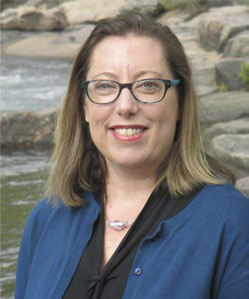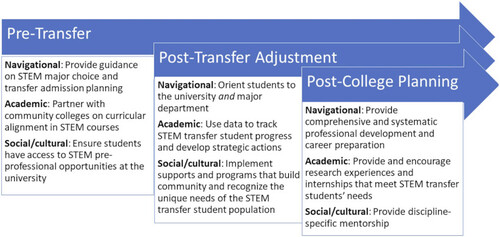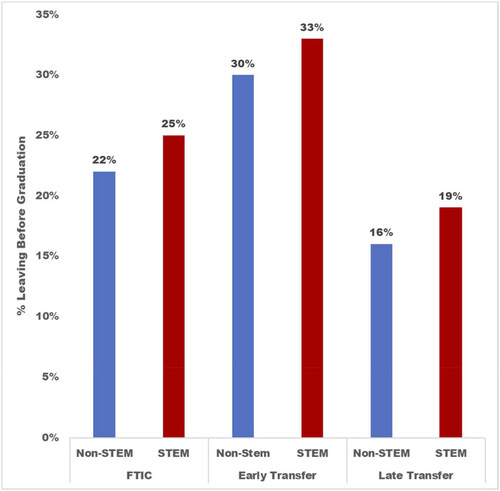In Short
Vertical transfer from community college to a university offers a promising, although unrealized, pathway to diversify STEM disciplines.
Studying how successful transfer-receiving universities support STEM transfer students can offer insights into the institutional practices that promote transfer student retention and success.
Using institutional data is crucial to identify vulnerable populations within the STEM transfer population and to design necessary changes in practice or policy, especially at the department level.
Providing discipline-specific multidimensional support throughout STEM transfer students’ undergraduate careers can improve transfer rates and retention and ease students’ transition to the university.
Although universities have developed promising practices and programs, support for STEM transfer students is not systematically available and should be more targeted, intentional, and comprehensive throughout the transfer and adjustment process.
The Promise and Challenges of the STEM Transfer Pathway
Due to their accessibility and affordability, community colleges enroll nearly half of all college students in the United States (Barrington, Citation2023). Given the diversity in community college enrollments, the vertical transfer pathway can play a vital role in broadening access to 4-year degrees in much-needed STEM fields. Yet this pathway has not lived up to its potential (Bahr et al., Citation2017), and transfer rates are declining, further constraining access to STEM bachelor’s degrees (National Student Clearinghouse Research Center [NSCRC], Citation2023). Even for students who have successfully transferred, bachelor’s degree completion in STEM majors is dependent on a complex mix of academic, demographic, and social factors (Wang, Citation2013; Zhang, Citation2022). To address this problem, we present a framework for transfer-receiving universities to apply that can help maximize the potential of the vertical transfer pathway to boost enrollments, diversify STEM fields, and provide access to lucrative careers for low-income and other students from underrepresented groups.
The vertical transfer pathway involves multiple navigational steps for students, from choosing a major, completing prerequisite coursework at the community college, and gaining admission to a university, to then integrating into the university and preparing for professional life after college. For STEM majors, rigid and sequential curricula and confusing transfer application requirements can present extra navigational obstacles that cost students time, money, and credits (Grote et al., Citation2021; Holland Zahner, Citation2022; Packard et al., Citation2012). STEM students may also encounter poor advising and misinformation at the community college or the transfer-receiving university (Harper & Thiry, Citation2022; Packard et al., Citation2011, Citation2012).
Once students transfer into a university, they must find academic support, peer community, and mentors, all while possibly facing transfer stigma and unwelcoming faculty (Holland Zahner & Harper, Citation2022; Jackson et al., Citation2013; Mobley & Brawner, Citation2019). Students’ declines in grades after they enter a university, termed “transfer shock,” can delay progress in sequential majors such as STEM disciplines especially (Lakin & Elliott, Citation2016). Differences in institutional cultures between community colleges and universities leave many transfer students, especially women and racially minoritized students, feeling isolated (Corwin et al., Citation2020; Jackson & Laanan, Citation2015). Transfer students also have less time at the university to engage in high-impact practices such as undergraduate research or internships, yet those who do participate have higher bachelor’s degree completion rates and are more likely to enter STEM careers (Dinh & Zhang, Citation2021; Jelks & Crain, Citation2020).
In our work as STEM higher education researchers, evaluators, and a former community college STEM dean, we have observed firsthand the challenges of the STEM transfer pathway and are committed to helping institutions improve this process for students. To this end, we present a framework of STEM transfer practices that can be applied by transfer-receiving universities to reduce the barriers inherent in the STEM transfer pathway. Our research findings extend the recommendations provided by Jain et al. (Citation2011) for creating a transfer-receptive culture at the university by providing financial and academic support, acknowledging students’ lived experiences, and using data to evaluate transfer student programs. We extend this work by presenting a research-based, STEM-specific framework for universities to support transfer students, from their entry into higher education at the community college through to bachelor’s degree completion and postcollege transitions.
How Can Universities Support STEM Transfer Students?
To answer this research question, we conducted a 5-year case study at three universities in three state contexts with successful transfer rates that had closed equity gaps in degree completion for racially minoritized students. We selected these campuses because we wanted to learn what effective institutions are doing to promote successful STEM transfer.
During campus site visits in 2018 and 2019, we interviewed 92 faculty, staff, advisors, and administrators. We then conducted interviews with 112 graduating seniors in STEM disciplines, including both transfer and first time in college (FTIC) students. Seniors were majoring in life sciences, physical sciences, engineering, computing, and mathematics. Almost all came from an underrepresented group in STEM, based on their gender, race/ethnicity, disability, first-generation college, or low-income status. We also administered a survey to all seniors (STEM and non-STEM majors) and received 2,035 complete responses. The survey and interviews addressed students’ major and college choices; classroom and cocurricular experiences; peer, faculty, and advisor interactions; and career planning. Finally, we collected 6 years of academic records for all enrolled students at two of the universities (the other campus was unable to supply this information). Interview data were content coded for emerging themes related to institutional support. Transcript data were analyzed using descriptive statistics and multinomial logistic regression. Survey data were analyzed using descriptive statistics, factor analysis, and linear and logistic regression.
An Evidence-Based Framework for STEM Transfer Student Support
Our research findings are intended to help universities better support students’ ability to successfully navigate the transfer process and thrive at the transfer-receiving university. We therefore frame our findings within STEM students’ transfer journey, from their start at community college, to entry into the university and eventual career planning and graduation. This framework is not an exhaustive list of all of the policies and programs that could possibly support STEM transfer but represents the actions taken by universities in our study that were deemed most impactful by faculty, advisors, administrators, and the students themselves. We also highlight areas where there were gaps in support. Overall, the framework emphasizes the need to consider STEM transfer students as a unique population deserving of discipline-specific services and resources targeted to their success. summarizes transfer stages and the institutional practices that we found promoted students’ ability to navigate the transfer process, achieve academically, and socially and culturally integrate into the university and their major department.
How Universities Can Benefit From Transfer Students
Transfer students can diversify the university student population and increase enrollments, which have generally been declining at many institutions since the pandemic (NSCRC, Citation2023). Although transfer students face stigma as being less prepared than students who entered directly from high school, this bias is unfounded. Transfer students can be very successful at 4-year universities, but the timing of transfer matters. Universities face pressure to admit transfer students as soon as possible—with only freshman or sophomore status—to increase tuition revenue, yet this practice may be penny wise and pound foolish (Couturier, Citation2023). We found that later transfers, meaning those who transferred with junior status, have higher rates of degree completion, potentially providing more revenue and increasing the university’s capacity to meet performance-based funding expectations. On the other hand, our regression analysis identified populations of transfer students that may be vulnerable to leaving the university without a degree, including those with early transfer status (transfer with less than 60 credits). Some of the other predictors of leaving the university entirely were the number of DFWI grades each student receives after transfer (grades of D, F, or a withdrawal or incomplete), part-time enrollment, and out-of-state residence. displays differences in the likelihood that FTIC, early transfer, and later transfer students will leave the university before completing their degree.
These quantitative findings indicate that specific subpopulations of STEM transfer students are especially vulnerable to leaving the university, even in institutions that have reduced overall disparities in graduation rates. More, therefore, can be done to support students throughout the transfer process. Our findings and corresponding framework offer evidence-based recommendations for how to do so.
Pretransfer: What Universities Can Do to Support Students Prior to Transfer
As part of their decision-making process, community college students need discipline-specific guidance about majors and career options as well as navigational knowledge of the transfer admissions process. Our findings indicate universities can take the following actions to support transfer-intending students while they are enrolled at the community college.
Pretransfer Navigation: Provide Guidance on STEM Major Choice and Transfer Admissions
We found that universities provided information about STEM majors, course pathways, and transfer application processes through advising days and informational tables at community colleges where institutional representatives could speak directly with transfer-intending students. However, this information did not reach all students, as some were still confused about STEM major choices and the connection between majors and careers. We found that community college students avoided majoring in physics and math because they did not see viable future careers associated with these majors despite their strong interest in the fields. Additionally, finding, interpreting, and adhering to transfer admission rules and criteria in STEM majors represented a substantial learning curve for many community college students despite application workshops hosted by universities. Too often, students in our study learned about vital admission information through happenstance and trial and error, suggesting that universities can make more systematic efforts to inform transfer-intending students about STEM major options and to smooth admissions processes into these majors.
Pretransfer Academics: Partner With Community Colleges to Ensure Curricular Alignment in STEM Required Courses
To smooth curricular pathways, some university departments partnered with local community college campuses to align curricula and conceptual content in key course sequences. At one university, math faculty on five local campuses worked together closely to ensure a smooth transition between required courses in the calculus sequence. Some universities enacted policies to ensure that students completed required courses for entry into the major at the community college prior to transfer. For example, one university began to require completion of calculus at the community college prior to transfer because its data showed that it led to higher STEM degree completion rates. Despite clear benefits, these promising interinstitutional collaborations and policies were not common.
Pretransfer Social/Cultural: Ensure Students Have Access to STEM Preprofessional Opportunities at Transfer-Receiving Universities
Transfer-intending students benefited from access to professional development opportunities in their major at the transfer-receiving university, whether through bridge programs or access to research opportunities. As an example, an engineering bridge program provided intensive advising, access to internships and research opportunities, tutoring, and peer community at both the community college and university. Students who were enrolled in bridge programs tended to find their dedicated program advisors much more helpful than traditional academic advisors, describing them as being “like family.” One of the universities in our study had a formal research program in which local community college students came to campus to conduct research with STEM faculty. Although these initiatives provided continuity of experience from community college to university, they were not implemented systematically, with access for students varying by institution and discipline.
Posttransfer Adjustment: What Universities Can Do to Support STEM Transfer Students’ Adjustment
STEM students have unique needs and can greatly benefit from targeted support after transfer, especially within their major department. Our findings indicate that universities and STEM departments can take the following actions to improve STEM transfer students’ adjustment and retention.
Posttransfer Navigation: Orient Students to the University and Major Department
Universities eased students’ adjustment in several ways, through university-wide transfer student orientations, academic success courses for transfer students, department-based transfer student orientations, and transfer student-centered advising practices. One-credit academic success courses for transfer students covered academic and campus resources along with success strategies such as study skills and time management. These courses also provided a peer cohort for entering transfer students. Although rare, department-based transfer student orientations contributed to students’ retention and sense of belonging in their major. Some departments provided continuing support, which took many forms, including near-peer and faculty mentorship, access to STEM transfer student clubs, and undergraduate research opportunities. Finally, STEM advisors who provided tailored and clear guidance on courses and pathways, as well as advice on discipline-specific internships and careers, were highly beneficial to students’ adjustment and academic progress.
Posttransfer Academics: Use Data to Track Progress and Determine Strategic Actions
The use of data to track progress and identify areas of concern was integral to the reduction of racial equity gaps in degree attainment at our study sites. Each university had a student success team—one university had a STEM-specific student success team—that met regularly to review data and develop strategic action plans based on findings. Success team members examined disaggregated data; for example, one university identified a large discrepancy in the retention and degree completion of Black men compared to other groups and began to develop initiatives to better support them. Success teams paid special attention to first-generation college students, monitoring their progress and outcomes and developing wrap-around programs to address their unique needs. Despite close collaborations across campus organizational units and responsive institutional research offices, only one of the campuses specifically examined outcomes for transfer students in a systematic way. Yet this type of analysis could yield actionable insights. Our analysis of transcript data showed that, even at comparatively successful institutions, both FTIC and transfer students were more likely to leave their university without a degree when they received even one DFWI grade. In fact, each DFWI grade that a student received increased their chances of leaving the university without a degree. A handful of STEM major requirement courses accounted for a disproportionate amount of DFWIs received by transfer students who left their university, specifically Computer Science I and II, Data Structures, Thermodynamics, Physics I and II, Organic Chemistry, Calculus II, and Linear Algebra. These courses create barriers to STEM transfer students’ success, and departments should review their structure and instructional methods to enhance student learning and improve outcomes.
Posttransfer Social/Cultural: Implement Supports and Programs That Build Community and Recognize the Unique Needs of the STEM Transfer Student Population
Peer community and supportive interactions with faculty and advisors promoted students’ adjustment and sense of belonging in STEM. Disciplinary-based academic clubs cultivated community by providing connections with like-minded peers and faculty. Several students credited STEM clubs with pulling them out of the grade slide associated with “transfer shock.” STEM transfer-specific clubs, although rare, were especially important to students’ social and cultural integration into their department. For example, one department created a transfer student club that provided peer mentors who were former transfer students. STEM faculty and advisors also supported students’ adjustment in many ways. As an example, some STEM faculty provided validating strategies for students to cope with and overcome struggles with STEM grades.
All institutions provided flexible academic resources that accommodated the busy and complex lives of transfer students, who are more likely to be returning adult learners, parents, commuters, or full-time workers. STEM departments implemented supplemental instruction in critical STEM courses. Some departments or tutoring centers offered virtual tutoring and flexible evening hours for working students to have easier access to this essential support. Even before the pandemic, some faculty offered virtual and/or evening office hours for commuter students, thereby increasing student use of this vital resource. Many STEM transfer students also formed friendships with peers at tutoring centers or supplemental instruction sessions that helped their social adjustment to their major department.
Postcollege Planning: What Universities Can Do to Support STEM Transfer Students’ Transition Into Further Education or the Workforce
Given that transfer students spend less time at the university than their FTIC peers, it is crucial that they have access to high-quality professional experiences, mentorship, and career planning and are supported in understanding the importance of these preprofessional opportunities. Our findings indicate that the following actions were beneficial to transfer students’ preparation to enter the STEM workforce or graduate school.
Postcollege Navigation: Provide Comprehensive and Systematic Professional Development and Career Preparation
We found some departments provided numerous preprofessional development opportunities to build students’ professional skills and STEM identity; however, there was variability among departments, with others offering very few opportunities. STEM transfer students tended to take advantage of workshops and career advising services in their department more often than those offered by the Career Center because they viewed them as more relevant. Some departments housed their own career advisors to assist students with career or graduate-school planning. A few departments required the completion of a one-credit professional development course that taught professional skills such as technical interviewing, teamwork and communication, STEM job searching, and networking. Informally, STEM clubs also played an important role in transfer students’ professional preparation by introducing them to career options in their discipline and providing speakers and role models in STEM careers. Some STEM clubs also offered skill-building opportunities, such as hack-a-thons, that provided hands-on, real-world technical experience. Transfer students who did not have access to discipline-specific career advising or professional workshops felt disadvantaged in their STEM job search or graduate application process.
Postcollege Academics: Provide and Encourage Internships and Research Experiences That Meet STEM Transfer Students’ Needs
In our survey findings, transfer students participated in internships and research experiences at slightly lower rates than their FTIC peers. Surprisingly, transfer students who did participate found these experiences somewhat less useful to their success, with statistically significant differences between the groups. We believe this finding points to a need to better engage STEM transfer students in high-quality experiences that will shape their STEM identity and prepare them to be STEM professionals. displays the participation rates in undergraduate research and internships and students’ perceptions of the value of these experiences for those who participated in them.
Figure 3. Participation and Efficacy of STEM Undergraduate Research Experiences and Internships
Figure 3. Scale is 1 = Not at all helpful to 4 = Very helpful.

Although only a quarter to a half of the transfer students in our study participated in undergraduate research or internships, our qualitative findings showed these experiences affirmed students’ major choices and helped them clarify their career path when they were high-quality experiences that provided mentorship, financial compensation, and access to meaningful projects. Paid opportunities allowed transfer students to quit low-paying service jobs and focus on acquiring professional experiences in STEM fields. Students noted that these experiences “really motivated me to keep going” and “made me feel like I could do this for many years.” Despite the wealth of benefits, some STEM transfer students in our study were not aware of these opportunities, did not feel that they could afford the time to participate, could not participate in unpaid opportunities, or did not have knowledge of how to find and apply to preprofessional opportunities. Nevertheless, these experiences could be highly impactful for those who participated and, in the case of internships, often led to full-time work after graduation.
Postcollege Social/Cultural: Provide Discipline-Specific Mentorship
STEM departments and faculty provided mentorship opportunities in several ways, including through research experiences, senior projects, workshops, conferences, and other interactions in or out of the classroom. STEM transfer students who participated in preprofessional clubs or programs were more likely to find mentorship and identify professional networks to support their transition into careers or graduate school. Transfer students who attended STEM conferences with faculty and peers—especially diversity-based conferences—were able to participate in career and interviewing workshops and interact with STEM professionals who offered insight into future career paths. Similar to other career-planning opportunities, these were not systematically available to all students and were unevenly distributed across campuses and disciplines.
Discussion/Conclusion
The pivotal transition points of the transfer and adjustment process present navigational, academic, and social/cultural obstacles for transfer students (Thiry et al., Citation2023). STEM transfer pathways will continue to exacerbate inequities rather than alleviate them unless institutions work more intentionally and systematically to support STEM transfer students (Wang, Citation2021). Our framework provides a mechanism for universities and STEM departments to assess their level of support for STEM transfer student success. Building on Jain et al.’s (Citation2011) tenets of transfer-receptive culture, we provide a framework of institutional actions that universities can undertake to support STEM transfer students’ navigational progress, academic success, and social and cultural integration to the university.
This framework is needed because our findings show that STEM transfer students are a unique population that merits more attention and support throughout their college careers. Institutional changes may be challenging, though, because transfer students are heterogeneous, and different groups experience different obstacles during the transfer and adjustment process (Ogilvie & Knight, Citation2021). Therefore, universities should examine their data to know who are their STEM transfer students, how they are doing, and where there are any disparities in degree or course outcomes, so institutions can design strategic actions accordingly.
The framework also shows that STEM transfer students need discipline-specific support. The department, rather than the larger university, is the source of STEM transfer students’ motivation, sense of community, and support (Holland Zahner & Harper, Citation2022; Thiry et al., Citation2023). To reverse steep national declines in transfer rates, it is crucial that universities reach out to and engage with STEM transfer-intending students while they are still in community college to inform them about STEM majors and career choices. Community college students who interact with university representatives before transfer are more likely to transfer into STEM majors (Holland Zahner, Citation2022; Wang et al., Citation2021). After transfer, departments can provide their own transfer student orientations and encourage transfer student participation in academic clubs and peer groups within their major department. STEM transfer students have less time at the university to build community, find mentors, and engage in high-impact practices (Dinh & Zhang, Citation2021) and therefore need more targeted support in these areas as well as encouragement and financial incentives to participate in them. In all, our findings reinforce the need for universities—and STEM departments—to intentionally and comprehensively foster a transfer-receptive culture that promotes the academic success and social integration of STEM transfer students.
Additional information
Funding
Notes on contributors

Heather Thiry
Heather Thiry ([email protected]) is a Senior Research Associate with Ethnography & Evaluation Research at the University of Colorado Boulder. Her research focuses on the institutional cultures and practices that support the persistence of marginalized students in STEM higher education.

Dana Holland Zahner
A social scientist by training, Dana Holland Zahner is a Researcher with Ethnography & Evaluation Research at the University of Colorado Boulder. Her research and evaluation interests bring together questions about student experiences and institutional practices, especially in STEM higher education pathways.

Timothy Weston
Timothy Weston works as a Senior Research Associate and Program Evaluator at the University of Colorado Boulder where he studies STEM education, student persistence, and undergraduate teaching. He specializes in research methodology, quantitative methods, and survey design and analysis.

Raquel Harper
Raquel Harper is a Research Associate with Ethnography & Evaluation Research at the University of Colorado Boulder, where she conducts research on undergraduate students’ experiences in STEM programs. She has expertise in mixed methods, qualitative research, science education and communication, and training in public health, and has worked in academia as well as the science and health industry.

Heidi Loshbaugh
A former community college STEM Dean, Heidi Loshbaugh is currently a Researcher with Ethnography & Evaluation Research at the University of Colorado Boulder. Her work focuses on the intersection of research, practice, and policy by supporting faculty and institutions to develop inclusive climates, undertake systemic innovations, and become more student centered.
References
- Bahr, P. R., Jackson, G., McNaughtan, J., Oster, M., & Gross, J. (2017). Unrealized potential: Community college pathways to STEM baccalaureate degrees. The Journal of Higher Education, 88(3), 430–478. https://doi.org/10.1080/00221546.2016.1257313
- Barrington, K. (2023). Community colleges are more important than ever. Community College Review. https://www.communitycollegereview.com/blog/community-colleges-are-more-important-than-ever
- Corwin, L. A., Morton, T., Demetriou, C., & Panter, A. T. (2020). A qualitative investigation of STEM students’ switch to non-STEM major post-transfer. Journal of Women and Minorities in Science and Engineering, 26(3), 263–301. https://doi.org/10.1615/JWomenMinorScienEng.2020027736
- Couturier, L. (2023). Unpacking financial disincentives: Why and how they stymie degree-applicable credit mobility and equitable transfer outcomes. Beyond Transfer Policy Advisory Board. SOVA. https://sova.org/wp-content/uploads/2023/02/Beyond-Transfer-Unpacking-Financial-Disincentives-Feb-2023.pdf
- Dinh, T. V., & Zhang, Y. L. (2021). Engagement in high-impact practices and its influence on community college transfers’ STEM degree attainment. Community College Journal of Research and Practice, 45(11), 834–849. https://doi.org/10.1080/10668926.2020.1824133
- Grote, D. M., Knight, D. B., Lee, W. C., & Watford, B. A. (2021). Navigating the curricular maze: Examining the complexities of articulated pathways for transfer students in engineering. Community College Journal of Research and Practice, 45(11), 779–801. https://doi.org/10.1080/10668926.2020.1798303
- Harper, R., & Thiry, H. (2022). Advising from community college to university: What it takes for underrepresented transfer students in STEM to succeed. Community College Journal of Research and Practice, 1–20. https://doi.org/10.1080/10668926.2022.2050842
- Holland Zahner, D. G. (2022). Opening the black box of vertical transfer admission: The experiences of community college students in STEM majors. Community College Journal of Research and Practice, 1–25. https://doi.org/10.1080/10668926.2022.2135041
- Holland Zahner, D. G., & Harper, R. P. (2022). Validation of belonging among underrepresented undergraduates in STEM majors: Comparison of former transfer and non-transfer students. Journal of College Student Retention: Research, Theory & Practice, 15210251221146119.
- Jackson, D. L., & Laanan, F. S. (2015). Desiring to fit: Fostering the success of community college transfer students in STEM. Community College Journal of Research and Practice, 39(2), 132–149. https://doi.org/10.1080/10668926.2012.762565
- Jackson, D. L., Starobin, S. S., & Laanan, F. S. (2013). The shared experiences: Facilitating successful transfer of women and underrepresented minorities in STEM fields. New Directions for Higher Education, 2013(162), 69–76. https://doi.org/10.1002/he.20058
- Jain, D., Herrera, A., Bernal, S., & Solorzano, D. (2011). Critical race theory and the transfer function: Introducing a transfer receptive culture. Community College Journal of Research and Practice, 35(3), 252–266. https://doi.org/10.1080/10668926.2011.526525
- Jelks, S. M., & Crain, A. M. (2020). Sticking with STEM: Understanding STEM career persistence among STEM bachelor’s degree holders. The Journal of Higher Education, 91(5), 805–831. https://doi.org/10.1080/00221546.2019.1700477
- Lakin, J. M., & Elliott, D. C. (2016). STEMing the shock: Examining transfer shock and its impact on STEM major and enrollment persistence. Journal of the First-Year Experience & Students in Transition, 28(2), 9–31.
- Mobley, C., & Brawner, C. E. (2019). “Life prepared me well for succeeding”: The enactment of community cultural wealth, experiential capital, and transfer student capital by first-generation engineering transfer students. Community College Journal of Research and Practice, 43(5), 353–369. https://doi.org/10.1080/10668926.2018.1484823
- National Student Clearinghouse Research Center. (2023). Transfer and progress fall 2022 report: A redesign of the COVID-19 transfer, mobility, and progress and tracking transfer series. https://nscresearchcenter.org/transfer-and-progress/
- Ogilvie, A. M., & Knight, D. B. (2021). Post-transfer transition experiences for engineering transfer students. Journal of College Student Retention: Research, Theory & Practice, 23(2), 292–321. https://doi.org/10.1177/1521025118820501
- Packard, B. W. L., Gagnon, J. L., LaBelle, O., Jeffers, K., & Lynn, E. (2011). Women’s experiences in the STEM community college transfer pathway. Journal of Women and Minorities in Science and Engineering, 17(2), 129–147. https://doi.org/10.1615/JWomenMinorScienEng.2011002470
- Packard, B. W., Gagnon, J. L., & Senas, A. J. (2012). Navigating community college transfer in science, technical, engineering, and mathematics fields. Community College Journal of Research and Practice, 36(9), 670–683. https://doi.org/10.1080/10668926.2010.495570
- Thiry, H., Harper, R., & Zahner, D. H. (2023). Navigating transfer “pivotal points” in challenging contexts: A longitudinal investigation of STEM transfer students’ pathways during COVID-19. Journal of College Student Retention: Research, Theory & Practice, 152102512311615. https://doi.org/10.1177/15210251231161576
- Wang, X. (2013). Modeling entrance into STEM fields of study among students beginning at community colleges and four-year institutions. Research in Higher Education, 54(6), 664–692. https://doi.org/10.1007/s11162-013-9291-x
- Wang, X. (2021). On my own: The challenge and promise of building equitable STEM transfer pathways. Harvard Education Press.
- Wang, X., Lee, S. Y., Nachman, B. R., & Zhu, X. (2021). It matters long before: How early exposure to faculty and advisors at baccalaureate institutions relates to upward transfer. Educational Researcher, 50(2), 105–114. https://doi.org/10.3102/0013189X20956659
- Zhang, Y. L. (2022). Early academic momentum: Factors contributing to community college transfer students’ STEM degree attainment. Journal of College Student Retention: Research, Theory & Practice, 23(4), 873–902. https://doi.org/10.1177/1521025119881130


